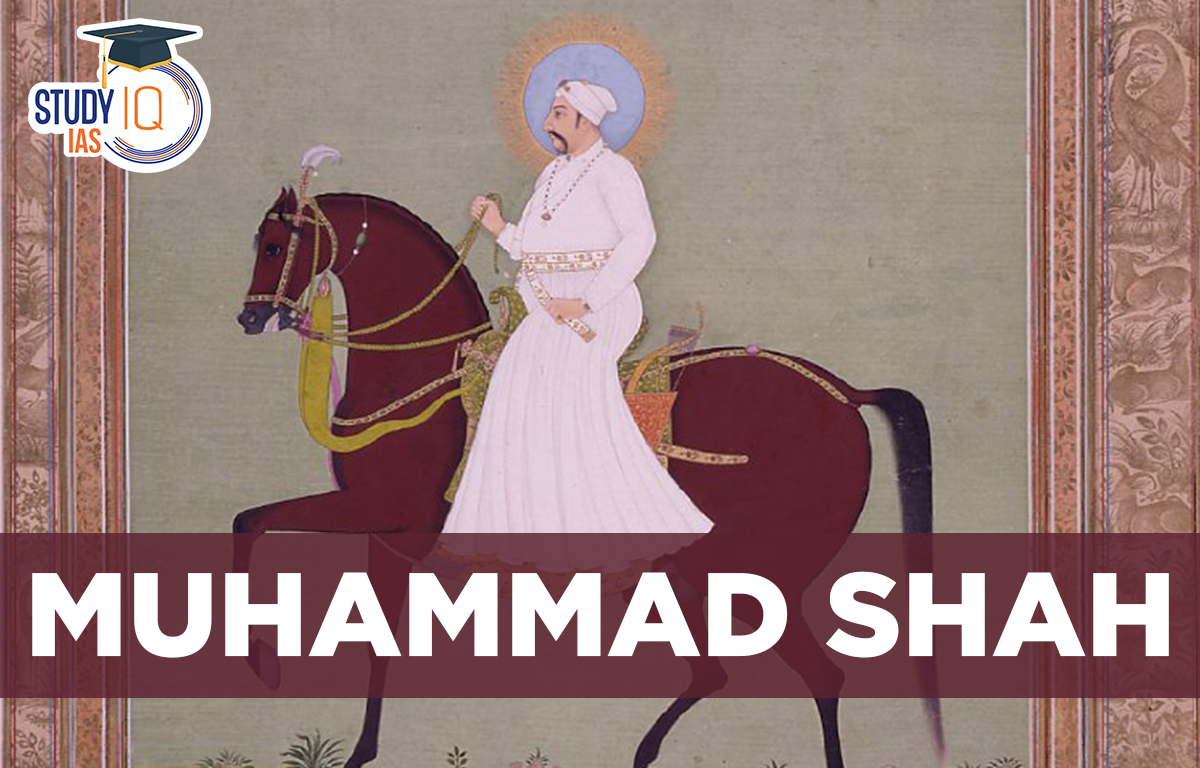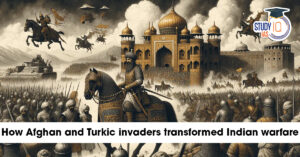Table of Contents
Muhammad Shah Introduction
Read all about Muhammad Shah in this article. Nasir-ud-Din The twelveth Mughal Emperor, also known as Muammad Shah, ruled from 1719 to 1748. He was the fourth son of Bahadur Shah I, Khujista Akhtar. With the help of the Sayyid brothers, Muhammad conquered the kingdom at the age of 17. You will learn about Mohammad Shah (1719–1748) in this article, which will help you with your preparation for the UPSC Civil Service Exam.
Mohammad Shah Early life
Khujista Akhtar, the fourth son of Bahadur Shah I, was his father. At the age of 17, he was able to take over the kingdom with the aid of the Sayyid brothers. Then he was able to get rid of them with the aid of Asaf Jah I. In Fatehpur Sikri, Syed Hussain Ali Khan was killed in 1720, and Syed Hassan Ali Khan Barha was poisoned to death in 1722.
Muhammad Shah was a fervent promoter of the arts, especially advances in music, painting, and administration. His pen name was Sada Rangila, and he also went by the names “Muhammad Shah Rangila” and “Bahadur Shah Rangila,” in honour of his paternal grandfather Bahadur Shah I. Despite Muhammad Shah’s support for the arts, the Mughal Empire fell quickly and permanently under his reign.
Nader Shah of Persia’s invasion and subsequent destruction of Delhi, the Mughal capital, hastened the Decline of Mughal Empire, which was already in decline. The events shocked and embarrassed the Mughals as well as other outsiders, particularly the British.
Mohammad Shah Reign
On September 29, 1719, Muhammad Shah assumed the title Abu Al-Fatah Nasir-ud-Din Roshan Akhtar Muhammad Shah and was installed at the Red Fort. However, the Sayyid Brothers kept a careful eye on the young monarch and gave his mother a monthly allowance of 15,000 rupees for her needs. In 1720, he successfully ousted the Saiyyad brothers with the help of Nizam-ul-Mulk, Chin Qilich Khan, and his father’s cousin Muhammad Amin Khan.
He designated Muhammad Amir Khan, the killer of Hussain Ali Khan, as wazir under the name Itmad-ud-Daula. The Mughal-Maratha Wars (1728–1763) will cause enormous destruction to the inhabitants of the mismanaged Mughal Empire during this time. The Malabar Coast developed into a well-protected haven despite attempts by the Nawab of Awadh Saadat Ali Khan and the Mughal Subedar in Bangalore, Dilawar Khan (r.1726-1756), to put down rebellions in 1724.
He did, however, see the rise of independent states: Saadat Khan governed Awadh, Murshid Quli Khan ruled Bihar, Bengal, and Orissa, and Nizam-ul-Mulk dominated the Deccan. The Mughal Empire’s frailty was revealed in 1739 CE when Nadir Shah invaded India, captured the Mughal emperor, and destroyed Delhi.
Since virtually all Persian forces had been enmeshed in the Mughal Empire before to Nader Shah’s invasion, Persia’s perennial enemy, the Ottoman Empire, seized the gap left at their Eastern frontiers quickly. Following the Mughal Army’s victory in the Battle of Manupur (1748) over yet another foe, Mughal Emperor Muhammad Shah continued to closely cooperate with Ottoman ambassador Haji Yusuf Agha until his death in 1748. During this period, the Mughal Empire was closely watching the Ottomans’ moves (Ahmad Shah Durrani).
The Mughal Empire was conquered by Ahmad Shah Durrani of Afghanistan in 1748. Ahmad Shah Bahadur, Grand Vizier Qamaruddin Khan and his son Moin-ul-Mulk, well known as Mir Mannu, Intizam-ud-Daula, and Safdarjung were sent with 75,000 soldiers after Shahnawaz Khan was defeated in Lahore.
The Battle of Manupur (1748) resulted in the defeat of Durrani’s 12,000 men, forcing him to resign. The Mughal Empire as a whole celebrated this occasion widely. The Battle of Manupur (1748) was won by the Mughal Army, although it cost a great deal of blood and treasure. He passed away on April 26, 1748, and visiting Imams from Mecca attended his funeral.
The Mughal Empire was destroyed by Nader Shah’s invasion, which put an end to what was left of it. After the invasion, the Mughals fell apart quite rapidly. The Mughal Army’s flaws were exposed after this invasion. Evidently, the Nawabs were powerless to free their captive metropolis of Delhi, which served as their base of operations. Following the Mughals’ complete wealth theft, rebellions and betrayal were common.
Mohammad Shah Contribution
During Muhammad Shah’s rule, qawwali was once again brought into the Mughal imperial court and quickly expanded throughout South Asia. Additionally, Muhammad Shah is credited with founding Islamic educational institutions like Maktabs. The Quran was first translated into simple Persian and Urdu during his rule.
The Sherwani replaced the customary Turkic garb that the aristocratic Mughal nobility had been donning because the Mughals were descended from Samarqand during his rule. Because Mohammad Shah prioritised the arts over administrative objectives, the government was able to fall.
Despite the decrease in Mughal governmental power under his rule, the Emperor supported the arts by working with talented artists like Nidha Mal and Chitarman, whose vivid paintings depict scenes from royal life such as Holi festivals, hunting, and hawking. Musicians of the Mughal court during the time included Naimat Khan, better known as Sadarang, and his nephew Firoz Khan, whose compositions popularised the Khyal musical style.
Despite the fact that Naimat Khan never performed it, Khyal was written for his supporters. An essential facet of Indian classical music emerged, rose, and won royal approval in the court of Muhammad Shah. During the reign of Muhammad Shah, Jai Singh II of Amber produced the 400-page Zij-i Muhammad Shahi, a significant scholarly work, between the years of 1727 and 1735.
Mohammad Shah Contribution
During Muhammad Shah’s rule, qawwali was once again brought into the Mughal imperial court and quickly expanded throughout South Asia. Additionally, Muhammad Shah is credited with founding Islamic educational institutions like Maktabs.
The Quran was first translated into simple Persian and Urdu during his rule. The Sherwani replaced the customary Turkic garb that the aristocratic Mughal nobility had been donning because the Mughals were descended from Samarqand during his rule. Because Mohammad Shah prioritised the arts over administrative objectives, the government was able to fall.
Despite the decrease in Mughal governmental power under his rule, the Emperor supported the arts by working with talented artists like Nidha Mal and Chitarman, whose vivid paintings depict scenes from royal life such as Holi festivals, hunting, and hawking. Musicians of the Mughal court during the time included Naimat Khan, better known as Sadarang, and his nephew Firoz Khan, whose compositions popularised the Khyal musical style.
Despite the fact that Naimat Khan never performed it, Khyal was written for his supporters. An essential facet of Indian classical music emerged, rose, and won royal approval in the court of Muhammad Shah. During the reign of Muhammad Shah, Jai Singh II of Amber produced the 400-page Zij-i Muhammad Shahi, a significant scholarly work, between the years of 1727 and 1735.
Mohammad Shah UPSC
Because the Sayyid Brothers were overthrown first, Mohammad Shah Rangila was able to rule for more than 29 years. Nadir Shah conquered Delhi during his rule, demolished the city, and took control of the Peacock Throne. Nadir Shah’s invasion hastened the fall of the Mughal Empire. Under his rule, the states of Hyderabad, Bengal, and Awadh were established as independent kingdoms. This article for UPSC Exam Preparation contains comprehensive information about Mohammad Shah.


 Birsa Munda Birth Anniversary 2025: Life...
Birsa Munda Birth Anniversary 2025: Life...
 Military Innovations of Afghans and Turk...
Military Innovations of Afghans and Turk...
 Self-Respect Movement, History, Objectiv...
Self-Respect Movement, History, Objectiv...

























